August 8, 2008
Air Date: August 8, 2008
FULL SHOW
SEGMENTS
Politics and Oil
/ Jeff YoungView the page for this story
Energy issues are center stage in Congress and on the campaign trail. The high cost of oil could push environmental concerns aside, as a push for more offshore drilling gains ground. Living on Earth's Jeff Young tells us what lies ahead in the drilling debate. (06:25)
Cheap Energy From The Sun
View the page for this story
MIT scientist Dan Nocera tells host Bruce Gellerman how to make cheap energy from a glass of water and photovoltaic solar panels. (05:30)
Going for the Green
/ Bruce GellermanView the page for this story
Eastern architectural traditions and Western contemporary design meet at the Beijing Olympic Green. A Massachusetts architectural firm won the international competition to design the Olympic master plan. Bruce Gellerman reports that the firm designs globally and practices what it preaches locally. (07:00)
China Renewables
View the page for this story
China recently surpassed the United States as the worst carbon dioxide emitter in the world. But it is also a world leader when it comes to developing renewable energy technologies like wind and solar. Host Bruce Gellerman talks with Changhua Wu, China director of the Climate Group and co-author of the recent report “China’s Green Revolution.” (05:00)
Back to School, Green
View the page for this story
St. Lawrence University is one of 450 colleges and universities in the U.S. to sign a petition promising to go carbon neutral. Host Bruce Gellerman turns to Louise Gava, the sustainability coordinator, or campus "eco lady," for a course in sustainability 101, and a little help with the back-to-school shopping list. (07:00)
The Art of Mud
/ Bethany EricsonView the page for this story
When commentator Bethany Ericson’s adult brother had some time on his hands, he decided to take up the Japanese craft of making perfect balls of mud. But his sister says the interest soon turned to obsession. (03:20)
Floating Windmills/Emerging Science Note
/ Jessica Ilyse KurnView the page for this story
Living on Earth's Jessica Ilyse Smith reports that researchers are working on wind turbines that will float on water. Modeled on deep-sea oil rigs the floating windmills will be able to harness the strong, consistent wind far out at sea. (01:45)
Prescription for Survival
View the page for this story
Sixty-three years after the nuclear genie was let out of the bottle with the bombings of Hiroshima and Nagasaki, the threat of nuclear warfare persists. But Dr. Bernard Lown, cardiologist and Nobel Peace Prize recipient, has a prescription for survival. He talks about it and his journey to save the planet during the Cold War with host Bruce Gellerman. (10:30)
This week's EarthEar selection
listen /
download
Show Credits and Funders
Show Transcript
HOST: Bruce Gellerman
GUESTS: Louise Gava, Bernard Lown, Willy Mook, Dan Nocera, Dennis Pieprz, Changhua Wu
REPORTERS: Bethany Ericson, Jessica Ilyse Smith, Jeff Young
[THEME]
GELLERMAN: From Public Radio International- this is Living on Earth.
[THEME]
I’m Bruce Gellerman. Double Double and a sea of troubles - oil on the minds of lawmakers has them reaching for the bard:
NELSON: I think we’ve changed the topic in Washington from whether this, uh, sort of Shakespearean, 'to drill or not to drill.' That’s no longer the question. what we have done is we have moved beyond that discussion to where we recognize that you have to do it all.
GELLERMAN: Perchance even to drill in the undiscovered country? Also, the grand green design for the Beijing Olympics.
PIERPRZ: It's really about trying to understand what the essence of what the place is about- because we wanted the Olympic green to be all about China, not an importation of a Western idea.
GELLERMAN: And China lets a thousand green technologies bloom. These stories this week on Living on Earth. Stick around!
[NPR NEWSCAST: ]
Politics and Oil
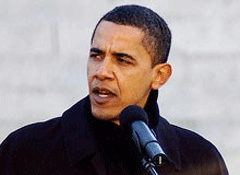
Senator Barack Obama.(Photo: Justin Shearer)
GELLERMAN: From the Jennifer and Ted Stanley Studios in Somerville, Massachusetts, this is Living on Earth. I’m Bruce Gellerman in for Steve Curwood. Energy issues are powering the political debate both in Washington and on the campaign trail this summer. Republicans including John McCain are demanding an end to the offshore drilling moratorium, while some Democrats, including Barack Obama, say well, ‘maybe.’ Living on Earth’s Washington correspondent Jeff Young digs into the shifting sands of the drilling debate.
YOUNG: As recently as June Barack Obama pledged to defend the moratoria that have kept oil rigs off most U.S. shorelines for nearly 30 years. But with public opinion shifting in response to high gas prices Obama hinted to a Florida newspaper that he would support an energy compromise that expands offshore drilling. He later explained himself in this speech on energy in Lansing, Michigan:
OBAMA: While I still don’t believe that's a particularly meaningful short-term or long-term solution, what I've said is ‘I’m willing to consider it if it’s necessary to actually pass a comprehensive plan.’ I'm not interested in making the perfect the enemy of good.
YOUNG: Obama’s speech reaffirmed his commitment to clean energy alternatives. He’d invest $150 billion over a decade in wind, solar and geothermal power and make those sources supply at least 10 percent of the nation’s electricity. He’d push for more plug-in electric hybrid cars and put a cap on carbon emissions. But it was the mention of offshore drilling that got the attention. One environmental group that has endorsed Obama, Friends of the Earth Action, expressed disappointment. But Obama campaign energy advisor Elgie Holstein insists this is not a major change in Obama’s position.
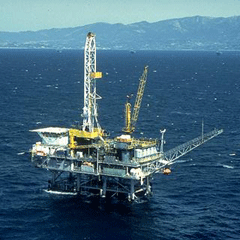
(Courtesy of Department of the Interior)
HOLSTEIN: It’s certainly not a flip-flop because he has supported offshore drilling all along. It’s just in these particular states where it has been prohibited by fed, law there he’s open-minded about any arrangement provided it protects our coastlines, provided states agree, and provided that it’s part of a bigger package in which we can start moving our economy towards a more sustainable energy future that isn't so reliant upon the imported oil from the Middle East.
YOUNG: But aren’t these sort of admissions that his more conservation-oriented agenda is not really connecting with the public and he needs to try something else here?
HOLSTEIN: I don’t think so. I think what it is is a confirmation of what he has said from the beginning of this campaign- that he’s a different kind of candidate, one who is willing to reach across aisle work with both Democrats and Republicans so we can break the gridlock that paralyzed Washington.
YOUNG: The compromise Obama supports came just as Congress left for its August recess after weeks of bitter deadlock.
Five Republicans and five Democrats announced the plan to allow drilling off of the coasts of five states_a win for Republicans. It would also strip from oil companies a multi-billion dollar tax loophole_a win for Democrats. Tax breaks would instead go to help auto companies make- and consumers- buy more efficient and more alternative fuel vehicles. Nebraska Democrat Ben Nelson thinks the Gang of Ten, as the Senators are called, could end the energy gridlock.
NELSON: I think we’ve changed the topic in Washington from this, uh, Shakespearean, to drill or not to drill. That’s no longer the question. What we have done is we’ve moved beyond that discussion to say you have to do it all.

Senator Barack Obama. (Photo: Justin Shearer)
YOUNG: The compromise plan would give Virginia, the Carolinas and Georgia the option to allow offshore drilling. And it would bring oil exploration as close as 50 miles to Florida’s Gulf coast.
Obama may be warm to the compromise but some of his environmental supporters are not. The League of Conservation Voters endorsed Obama. But League leader Gene Karpinski says the centrists’ plan is a bad deal because it only asks for voluntary steps toward more fuel-efficient vehicles.
KARPINSKI: The kinds of potential positive steps from that compromise aren’t required as far as we've seen in the proposal so far. So if we’re going to be serious about increasing fuel economy, we need mandatory standards to make sure car companies do their job.
YOUNG: The details of that compromise will have to wait until Congress returns from its recess. And a group of pro-drilling Republicans is trying to bring them back early. They’re taking to the darkened floor of the House chamber each day in a protest, demanding a drilling vote. They even brought former House Speaker Newt Gingrich back to the Capitol to say he thinks Republicans are winning on the issue.
GINGRICH: My hunch is that back home right now there are a lot of Democrats who are tap dancing saying 'oh, gosh. I’m really kinda for more energy, I’m really kinda for more drilling.'
YOUNG: Gingrich has confidence that offshore drilling would quickly bring down gas prices. Most economic forecasts do not. The American Petroleum Institute_the oil industry’s trade group_says it would likely take seven years or more to get more oil from the coasts. And the government’s energy information agency says opening all the coastline to drilling would not significantly affect prices before the year 2030. But Gingrich is not deterred.
GINGRICH: They’re just wrong. Economists believe the minute you agree to start drilling you're going to have a decline in price that minute.
YOUNG: More than a million people signed Gingrich’s online petition called ‘drill here, drill now.’ And that slogan has become part of the stump speech for Republican presidential candidate John McCain, who clearly thinks he’s tapped into a winning issue. For Living on Earth, I'm Jeff Young in Washington.
GELLERMAN: Jeff, stay with us for just a minute. How do you see this drilling debate playing out on Capitol Hill?
YOUNG: This is a serious challenge to Democrats. They’re just getting hammered over gas prices. Republicans look like they're blocking alternative energy. So come September I think this compromise proposal in the Senate will be getting a lot of attention. Senate Majority Leader Harry Reid told me he thinks the centrists’ plan is something he can work with.
GELLERMAN: And so what happens to the moratorium on offshore drilling?
YOUNG: So far the Democrats have avoided a vote on it. But they’ve got to vote sometime before the election because the moratorium only exists year to year and it expires at the end of September. And it’s not clear if Democrats have the votes to keep it in tact. Though, I think that again points to a compromise as a way for each side to back down from this standoff.
GELLERMAN: Thanks a lot, Jeff. You can hear more of Jeff Young's interview with Senator Obama's energy advisor and check out our campaign coverage online at L-O-E dot O-R-G.
Related links:
- **WEB EXTRA** Listen to an interview with Obama’s campaign energy advisor Elgie Holstein
- An overview of the Senate “Gang of Ten’’ compromise energy plan
- Sen. Barack Obama’s energy speech August 4th in Lansing, Michigan
Cheap Energy From The Sun

Daniel G. Nocera, Professor of Chemistry and Energy, MIT. (Photo: Jackson Braider)
GELLERMAN: In one hour enough sunlight falls on the earth to power the world for a year. There are just two problems with solar energy: it’s still expensive- and night. But now researchers at the Massachusetts Institute of Technology have figured out a way to store solar energy when the sun don’t shine. To accomplish the technological trick, the scientists sort of turned over a new leaf: their innovative process imitates what nature does: photosynthesis. The breakthrough appears in the latest edition of Science. MIT’s Dan Nocera is lead author. Professor Nocera, welcome to Living on Earth.
NOCERA: Thanks, it’s great to be here.
GELLERMAN: So tell me about your discovery. This is exciting stuff.
NOCERA: Yeah, it is exciting. The neat thing about this discovery is we do sort of what nature does. We store sunlight in chemical bonds of hydrogen and oxygen so we can split water to hydrogen and oxygen. And we do it with a catalyst that’s really cheap and we do it under conditions that are really cheap, so that’s what makes this discovery interesting and important.
GELLERMAN: So how do you do artificial photosynthesis?
NOCERA: In place of the leaf we put a photovoltaic, so the photovoltaic catches the light and it makes a wireless current and then it can feed that current to our compound. Our compound takes water to oxygen, but the main part is splitting that water and that’s what we can do now- and we can do it in a glass of water.
GELLERMAN: You know you got me searching back in memory for my high school chemistry.

Daniel G. Nocera, Professor of Chemistry and Energy, MIT. (Photo: Jackson Braider)
NOCERA: Yeah, that’s right. Go ahead, tell me about it. You remembered seeing a teacher probably use electrodes and put ‘em in water and make hydrogen and oxygen using electricity from the wall.
GELLERMAN: Exactly.
NOCERA: They were using the platinum to make hydrogen- that was the thing that was dipping in the water. And on one side you saw the hydrogen bubbles coming out but the thing they didn’t tell you is on the other side, where you were making the oxygen at another platinum electrode, that doesn’t work so well. So what the teacher was doing, was she or he was goosing the cell, and they were just turning the electricity up and that’s how they got the O2- that’s called overpotential. They had to use a lot of extra energy to get the O2 out and that’s what you don’t want to do if you’re building an energy economy, you don’t want to waste any of that kind of energy. And this new catalyst doesn’t waste that much energy.
GELLERMAN: Well you still gotta put energy into the system.
NOCERA: Sure do, nothing comes for free. And so what we’re really doing is if we’re getting that hydrogen and oxygen, where’s the current coming from? Well in this paper we just published we did it out of the wall- and remember the electricity from the wall comes from a coal fire power plant- but we were doing that just because we’re scientists and we were working on the catalyst. What you want to do is get rid of the wall current. The catalyst doesn’t care where the current comes from so the next thing is put the photovoltaic there, and that photovoltaic is getting powered by the sun.
GELLERMAN: So what you’ve come up with really is the catalyst, that’s they key here.
NOCERA: That’s right, it’s just the catalyst and the neat thing about this catalyst is that it’s a glass of water.
GELLERMAN: It’s a big deal, isn’t it?
NOCERA: It’s a big deal in that it’s cheap. We still have a way to go for technology but I’m kind of hopeful. You know there’s a lot of companies who have contacted me, big ones, who say, ‘Look, we know how to deal with hydrogen and oxygen and we know how to do small power systems but the way we do our hydrogen is we do what’s called reforming.’
They have big plants and they get their hydrogen from fossil fuels and make CO2 and then they get their oxygen by cryogenically freezing it, by making the air cold and taking it out. That’s really expensive and you need big plants. So that little village hut in India, you can’t set up those plants. But now if you can make hydrogen and oxygen out of a glass of water, you can start to envision a widely distributed energy system and for me, I want to start in the third world that’s where I’m most interested in and then we can start moving it to other places.
GELLERMAN: What do they say about imitation- it’s the sincerest form of flattery?
NOCERA: Um, sure is.
GELLERMAN: Well, here you are, imitating nature.
NOCERA: And I love nature. At the end, plants are super-efficient at using and converting energy. But guess what they don’t do? Store it. And you know that. Did you ever see a fat tree? I haven’t. And so they’re using most of that energy to live and it only stores a little bit of energy. This thing, I can take all that energy and use it for storage. So I really, I couldn’t be more happy than imitating nature because she’s my hero.
GELLERMAN: Professor Nocera, I heard that you were a big Dead-Head.
NOCERA: I am.
GELLERMAN: Grateful Dead fan, huh.
NOCERA: Yup, since I was a little kid, fourteen years old.
GELLERMAN: Well is there a song that comes out of that catalog that might suit our topic here?
NOCERA: You know, there’s a lot of them, but I think about “Touch of Grey” and it was Jerry Garcia and he was basically saying, ‘it’s gonna be okay as I get older.’ And that’s what I’m hoping, that it’s going to be okay as I have more touches of grey in my hair too. And I wish Jerry were here. I know he’d be happy.
[LAUGHTER]
GELLERMAN: Well thank you very much Professor Nocera, it’s been a real pleasure.
NOCERA: Thanks so much, too. We’re going to keep working hard for you guys.
GELLERMAN: Dan Nocera is the Henry Dreyfus Professor of Energy and Professor of Chemistry at MIT. His co-author is Matt Kanan. His article is published in the Journal of Science.
Related links:
- Daniel G. Nocera’s website
- To learn more about the discovery, click here
[MUSIC: Grateful Dead “Touch Of Grey” from ‘In The Dark’ (Grateful Dead Productions--1987)]
GELLERMAN: Coming up: Going for the green as well as the gold at the Beijing Olympics. Just ahead on Living on Earth.
Going for the Green
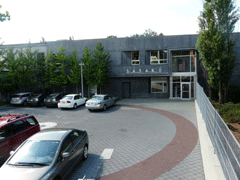
Sasaki Associates’ master plan for the Beijing Olympic site won the international competition. (Photo: Bruce Gellerman)
GELLERMAN: It’s Living on Earth, I’m Bruce Gellerman.
It’s an architect’s dream: you’re given a huge parcel of city space and told to lay the groundwork for a world-class event. Well, for Dennis Pieprz, it was a dream come true. Pieprz is president of the architectural firm, Sasaki Associates, and he remembers the day well. It was six years ago, mid-July, a Sunday. Pieprz was in his office, catching up on some work, when one of his employees, who was reading a Chinese newspaper online, got excited.
PIEPRZ: And he suddenly jumped up, and said, ‘We won! We won!’ And I wasn’t expecting to hear any news so I didn’t have any idea what he was talking about and he said, ‘We won the Beijing Olympics competition!’
[OLYMPIC THEME]
GELLERMAN: Sasaki Associates came up with the design for the 29th Olympiad, beating out 92 competitors around the world. China challenged all comers to create a master plan for the Beijing Games using a 2,500-acre plot of land incorporating a forest park, little used agricultural fields, and some buildings left over from the 1990 Asian Games. Just as the Chinese proverb says, ‘a journey of a thousand miles begins with a single step,’ so too creating a master plan for the Games begins with a design concept, or what Pieprz calls, ‘a framework for the Olympic Green.’
PIEPRZ: It’s really trying to understand what the essence of the place is about because we wanted the Olympic Green to be all about China, not an importation of a Western idea.

Sasaki Associates’ master plan for the Beijing Olympic site won the international competition. (Photo: Bruce Gellerman)
GELLERMAN: Traditional Chinese urban design lays out streets in neat grids and uses gateways to enclose large places like Tiananmen Square and the Forbidden City- monumental sites built on a north-south axis.
PIEPRZ: Our idea was to develop a concept that would be highly connected and integrated with the existing city- but not any of the adjacent neighborhoods and district, but the real heart of the city. And so we organized our scheme around this great north-south axis.
GELLERMAN: Sasaki designers wanted to maintain traditional ways- with a twist. Along the great north-south axis connecting Beijing’s great historic sites is where Pieprz’s planners designed East would meet West. They placed the National Stadium to the right of the axis, and the Water Sports facilities to the left, creating a gateway effect: Eastern essence, with a modern Western flavor.
PIEPRZ: We decided to put the stadium off the axis, letting the axis run through, really for future generations to deal with, and felt that people needed to be at the center of the place- not an object or some stadium that may last who knows how long.
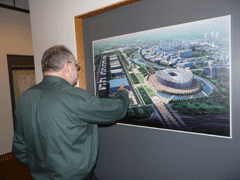
Dennis Pierprz, president of Sasaki Associates, points out features of the design of the Olympic Green. (Photo: Bruce Gellerman)
GELLERMAN: Pieprz’s goal was to create a site that was sustainable. He’s keenly aware that Olympic games can be a sporting success, the site can be a failure in the future. It happened after 1976 at the Montreal Olympics and the 2000 Games in Sydney, Australia.
PIEPRZ: The problem in Sydney is that the Olympic site and its Olympic-produced facilities were hardly being used. And they had some of the most incredible public spaces and investment in public space and here was an area that for example, the arena only used like 29 times a year, the stadium only 10 times a year for rugby.
GELLERMAN: Pieprz says the way to connect a new urban district with an existing city is to take advantage of population density, designing a site that puts people, not buildings, front and center, providing them with access to public transportation and proximity to facilities they’ll need and use. For Beijing, the Sasaki plan calls for 28 million square feet of new buildings- buildings most Olympic viewers will never see.
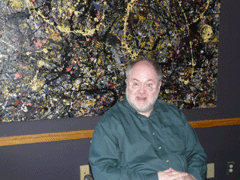
Dennis Pierprez, president of Sasaki Associates. (Photo: Bruce Gellerman)
PIEPRZ: Only a small fragment of the overall plan is actually built. But our plan and the city’s goal was to create a new district- a mixed-use district. So coming after the Olympics is a whole array of other uses like hotels, retail, commercial. All going to much more strongly define the major spaces that have been built for the Olympics.
GELLERMAN: When you watch the Olympic games you’ll be looking at a site in China, designed by a firm founded by a Japanese Architect, lead by a native born South African, based in Watertown, Massachusetts, a city located half a dozen miles west of Boston along the Charles River.
[DRIVING, WATER NOISES]
GELLERMAN: A dam built more than 200 years ago once powered the series of mill buildings that make up Sasaki’s world headquarters here in Watertown. It’s where the sails for the USS Constitution, Old Iron Sides, were made.
MCCOWAN: You can imagine that the most sought after desk locations are right here along the river, where you can open window and listen to the sound of the river.
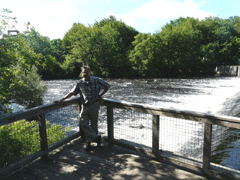
Jim McCowan, director of communications for Sasaki outside the company’s building on the Charles River. (Photo: Bruce Gellerman)
GELLERMAN: Jim McCowan, is a spokesman for the architectural company. In keeping with Sasaki’s work principles: design globally, act locally, they’re put into practice what they preaching for the Olympics: putting people at the center of the project. At corporate world headquarters in the renovated mill buildings, the prime locations along the Charles River are public spaces: a library and cafeteria. And today, sustainability is a priority.
MCCOWAN: And you know back then the environment not a priority, and so obviously there was a lot of pollution that took place. So now in some ways we're making up for it.
GELLERMAN: And how! Sasaki updated and refurbished the old factory using green design concepts and materials. Meredith Elbaum, is director of sustainable design at Sasaki
ELBAUM: You know to tell you the truth and may be this is inspiration for other people, I think it’s a lot of common sense. I mean we really haven’t done a lot of radical things.
GELLERMAN: They use recycled materials when possible, environmentally sound cleaners, carpets and paints. Workers get free public transit passes, hybrid drivers get choice parking spaces. And once a year employees goes dumpster diving to see how much more they can recycle.
Meredith Elbaum says they also studied using the old waterfall to generate electricity, but it would be too expensive. One big thing that did pay off: Sasaki installed automatic light dimmers. Workers don’t notice the change, but the electric company sure did:
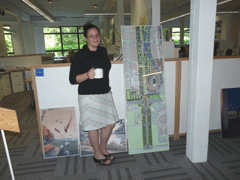
Meredith Elbaum, director of sustainable design at Sasaki. (Photo: Bruce Gellerman)
ELBAUM: It got to a point that the utility actually came by because they though our meters were broken because we had reduced our electricity so much by 34 percent in two years, they thought our meters were broken.
[OLYMPIC THEME MUSIC]
GELLERMAN: Victory again for Sasaki Associates, the company that won the international design competition for the Olympic Green, recently received the U.S. Green Energy Building Council’s Gold LEED certification, making the firm’s headquarters the oldest building in the nation to win the coveted award.
[OLYMPIC THEME MUSIC CONTINUES]
Related link:
Sasaki Associates
China Renewables

In a scene reminiscent of the 19th century, coal carts are hauled through the streets in China. Many hope China will leap frog the development paradigm of the West and limit the duration of their polluting industrial revolution. (Courtesy of USGS)
GELLERMAN: Despite the pomp, a cloud still hangs over the Beijing Olympics, or as some have dubbed it: Greijing. Pollution persists in the capital- resisting China’s efforts to clean the air. But, there may be clearer skies on the horizon: a new report says China is in the process of cleaning up not just its act but other countries’ as well.
The report, “China’s Clean Revolution,” was written by the independent organization The Climate Group. Changhua Wu, co-author of the study says, China is working on many different green technologies:
WU: The list is pretty long and if you look at renewables, wind definitely is getting stronger and has been developing very, very fast. Definitely China has been producing, manufacturing a lot of Solar PV, mostly exporting to the developing world at this moment. Looking at a lot of other applications, like solar water heaters, China definitely is among the largest one in the world. And then down the list, and there is like biofuels, which is still controversial internationally but somehow China is also developing fast. Hydro is definitely on the list and China has been leading the technology in hydroelectricity and not only the large hydro but also the small and medium sized hydrotechnology as well. Unfortunately, China has to rely on coal mostly for its power but what’s encouraging for us to see is that the government and also the companies in China, are investing heavily in clean coal technology. So if you look at the clean coal technology that has been used worldwide, China is pretty much leading already.
GELLERMAN: I understand that in 2007, China invested, what, $12 billion in renewable energy technologies and that’s second only to Germany. Why are renewables getting so much attention in China right now then?

Chenghua Wu is the China director of The Climate Group and co-author of the report “China’s Clean Revolution” (Courtesy of The Climate Group)
WU: The fact is that China today has to continue to rely on the coal but in the meantime we all know the coal factory is not only the major source of greenhouse gases but also domestic pollution. And so for the government basically it’s very, very crucial to look for alternatives. So investing heavily in the renewable energy sector is part of the national strategy to shift the country’s reliance on coal to other, cleaner, options.
GELLERMAN: Because according to the World Bank as you well know 20 of the 30 most polluted cities in the world are located in China.
WU: Unfortunately, it is at this right moment. That’s also part of the challenge that the top leadership has been trying to grapple with.

In a scene reminiscent of the 19th century, coal carts are hauled through the streets in China. Many hope China will leap frog the development paradigm of the West and limit the duration of their polluting industrial revolution. (Courtesy of USGS)
GELLERMAN: Your economy is accelerating so fast. I was reading the other day that by what, 2020, they hope to quadruple the per capita income?
WU: Well, this mainly where the country stands today if you look at economy development. And China is a developing country and has to continue to grow even though China kind of has created an economic miracle in the last three decades or so by lifting millions, you know, hundreds of millions of people out of poverty. But in reality, we still have a lot of people living in poverty. So China still at this kind of early stage of industrialization- the U.S. and many European countries have done your part- and now it’s China. And at this moment we’re hoping that China will not totally repeat the pathways of North America and European countries have taken in the industrialization process and hopefully we’ll find kind of cleaner, more efficient, low-carbon options.
GELLERMAN: Well, right now for the Olympics they’re cutting back on the number of cars that are entering the city of Beijing. What is China doing in terms of fuel-efficient cars and alternative fuels?
WU: There are two things I think the Chinese government has done. And one is dramatically improve the fuel-efficiency standards and we all know actually that the current standard in China is much higher than in the United States and still a little lower than that in Europe and in Japan. The second thing actually is that we started to see like more investment coming into more energy-efficient compact cars instead of really SUVs, stuff like that, and hopefully more and more people will start to buy more you know energy efficient cars rather than, you know, what you call a gasoline guzzling SUV.
GELLERMAN: Well, let me ask you to look out twenty, thirty years from now in terms of the conditions in China relative to clean technologies and renewables. Is China going to be significantly cleaner, do you think?
WU: I can bet on that and I’m pretty sure that down the road in twenty to thirty years, China will become a world leader around clean technology. Not only really a user of clean technology, but also a producer and a supplier for the rest of the world the clean technology as well.
GELLERMAN: I think if Chairman Mao was around today he might say something like, ‘Let a thousand clean technologies bloom.’
[WU LAUGHS]
WU: Probably.
GELLERMAN: Well, Ms. Wu I want to thank you very much.
WU: Thank you.
GELLERMAN: Changhua Wu is the director of the non-profit organization The Climate Group.
Related link:
The Climate Group
Back to School, Green

St. Lawerence University
GELLERMAN: On the campus of St. Lawrence University in upstate New York, Louise Gava is known as ‘the eco lady.’ Officially, she’s coordinator of sustainability projects. St. Lawrence is one of over 500 colleges and universities in the nation that have signed onto the President’s Climate Change Commitment, promising that their campuses will go carbon neutral. As students head back to school we turn to Ms. Gava for a quick lesson in sustainability 101. Ms. Gava, welcome to Living on Earth.
GAVA: Thank you.
GELLERMAN: Now I understand that St. Lawrence has come up with something called the “Sustainability Shopping List” for incoming students, right?
GAVA: We have.
GELLERMAN: So, what’s on the list?
GAVA: Well, I think the first thing to note is we want that list to be as short as possible. In other words, I tell people, ‘don’t buy stuff!’
GELLERMAN: Yeah, I guess you’re going to have a lot of parents who are cheering you on.
[GAVA LAUGHS]
GAVA: I’m everybody’s best friend and worst enemy at the same time.
GELLERMAN: So what is on the buying list?
GAVA: Well, quite a lot of things and they’re really easy to procure. One thing would be a power strip, and it needs to have an on-off switch, compact fluorescent light bulbs, a bike, reusable mug for hot beverages, and often you know students like to carry those refillable water bottles as well, reusable bags for going down to the bookstore or the grocery store as well. And then when you’re buying things like you’re refrigerators, make sure they’re Energy Star.
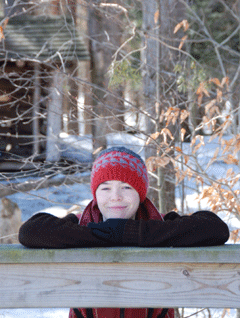
Louise Gava graduated from St. Lawrence University in New York State two years ago and has been greening the campus ever since.
GELLERMAN: I know you have on your website- you have something called the “Dollar Bill Test.”
GAVA: Yes! And that’s something that I have yet to find a mini-fridge that passes. And what I do is I go into students’ rooms and I do an energy audit of their rooms. And one of the things we do is we take their refrigerator and we stick a dollar bill in and you know we close the door and they always fall down to the bottom which means that seal around the refrigerator is not very tight which means, you know, one, it probably has to work a lot harder to keep things cold so you may have to turn it up more or just end up more or just end up with I don’t know, soggy grapes or really warm soda- I won’t say what else students like to put in their refrigerators. And so the dollar bill test generally has failed every time I’ve been in a college dorm.
GELLERMAN: You’re testing your students even before they get to class.
GAVA: I am, I am. And you know it’s interesting because I grade them as well. When I do this audit, we have, you know, there’s a grading system and what students’ in theory are shooting for is not a 4.0, but it’s to be a sustainability superstar. And what that means is they get a green star slapped on their door and it says, ‘sustainability superstar-ask me how you can green your room.’
So in other words, those students then become peer educators. You have passed, I have come in and I have questioned you, I have looked at what is in your room, I have asked you questions about do you know where you can find all the information on St. Lawrence’s website about sustainability. Then I ask you, ‘What are your behaviors?’ You know, do you go into the bathroom and run that water, for you know, the two minutes in theory or happy birthday or whatever-long that you’re brushing your teeth? So we talk about all those things, we add up their points, you know beyond things like what’s in your room, are you using your power strip, let me see the energy settings on your computer.
GELLERMAN: Well Louise, lets put these questions to one of your new incoming students. Willy Mook is joining us from Augusta, Maine and welcome, to Living on Earth Willy.
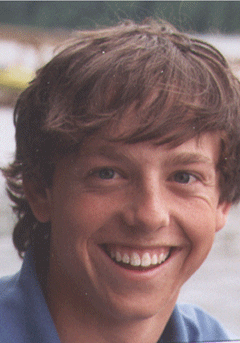
Incoming St Lawrence freshman, Willie Mook.
MOOK: Thank you.
GELLERMAN: This is going to be your first year then, right?
MOOK: Yes.
GELLERMAN: Well, have you looked at the website where there’s this sustainability list?
MOOK: I have.
GELLERMAN: And what do you think?
MOOK: I think it’s definitely something I’m going to look into as I’m looking into purchasing things for my dorm room and just how I’m going to live my life at St. Lawrence.
GELLERMAN: Louise mentioned saving water.
MOOK: Yes.
GELLERMAN: I noticed that the list suggests something called a Navy shower.
[LAUGHTER]
GAVA: Yes.
MOOK: I noticed that too, actually.

St. Lawrence University
GELLERMAN: Yeah, well, you know what it is?
MOOK: Yeah, I guess you soap up with no water running and then you just use the water to rinse off quickly.
GELLERMAN: Louise, you know when I was going to school, my generation we had a motto, ‘Save water, shower with a friend.’
[LAUGHTER]
GAVA: Ooooooh. I’m not sure that all the university would advocate for that, but maybe.
GELLERMAN: Times have changed.
GAVA: Yeah.
GELLERMAN: So what do you think there Willy, navy shower for you?
MOOK: Ooh, maybe not everyday, but I maybe, once in awhile, you never know.
GAVA: Well, I would note, Willy, you got one thing wrong. You do gotta turn on that water first.
MOOK: Right.
GELLERMAN: These are the basics there, Willy.
MOOK: Haha, thank you.
GELLERMAN: Now I also noticed they suggest bringing your own forks and spoons. What’s that about, Louise?
GAVA: Well, we have two main dining facilities on campus and only one of our dining facilities has utensils that are washed. So if you are going to what we call the Pub, you will be using, and you don’t bring your own utensils, you will be using plastic fork, spoon, knife. So it is preferred and we would love to see students take the initiative to stick a fork and a spoon or a knife or whatever in their bag and when they go to grab lunch they don’t need to take one of those plastic utensils and they can actually just pull their utensil right out of their bag.
GELLERMAN: What do you think there, Willy?
MOOK: Yeah, I think that’s a great idea, I think we should all cut back on our plastic consumption that isn’t reused.
GELLERMAN: Well what about a bike Willy, you got a bike?
MOOKE: Yes, I’ve got two bikes.
GELLERMAN: Oh, are you going to bring them to school?
MOOK: Um, I’m planning on bringing at least one of them, yeah.
GELLERMAN: Because I understand Louise, you have got a bike rental system there on campus.
GAVA: We do have a bike rental system. It’s called “the Green Bikes Program.” And just like you can go to the library and check out a book, you can go to the library and check out a bike.
GELLERMAN: What’s gonna be your major there, Willy?
MOOK: Um, probably environmental science.
GELLERMAN: Well Willy, good luck!
MOOK: Thank you very much.
GELLERMAN: And Louise, thanks very much for your time.
GAVA: You’re welcome, thank you.
GELLERMAN: Louise Gava is sometimes known as the ‘eco-lady.’ She’s the coordinator for Sustainability Projects at St. Lawrence University in upstate New York. And Willy Mook is an upcoming freshman from Newcastle, Maine.
Related link:
To see St. Lawrence's back-to-school shopping list, click here
[MUSIC: Coldplay “Yes” from ‘Viva La Vida’ (EMI Records--2008)]
GELLERMAN: Coming up: The world made mudilicious: get down and dirty and stay tuned to Living on Earth!
ANNOUNCER: Support for the environmental health desk at Living on Earth comes from the Cedar Tree Foundation. Support also comes from the Richard and Rhoda Goldman Fund for coverage of population and the environment. And from Gilman Ordway for coverage of conservation and environmental change. This is Living on Earth on PRI: Public Radio International.
The Art of Mud

An imperfect mudball (Bethany Ericson)
GELLERMAN: It’s Living on Earth, I’m Bruce Gellerman. Digging in the dirt can be great summertime fun, but for commentator Bethany Ericson, her brother went too far.
ERICSON: Last summer, my brother had a thing for mud. What’s unusual about this is that my brother is a 41-year-old academic.
One minute he was reading random articles online, and the next he was transfixed with the dirt in his yard.
He’d read that Japanese schoolchildren were going through a craze of making perfect mud balls in playgrounds.
These mud balls, called hikaru dorodango, aren’t just balls of wet soil. They’re perfectly smooth, dry balls encased in a glossy shell. Supposedly patiently layering mud, then burnishing it with fine dirt can achieve this, and my brother was determined to find out.
Neither of us had ever made a ball of dirt look like a polished marble when we were kids. Nor had anyone we knew heard of a dorodango. My brother lives in a tiny, forested town with dial-up internet service, but he was intrigued enough to sit for ten minutes stabbing at pop up ads just to carefully watch a video of someone stroking a handful of mud.

An imperfect mudball (Bethany Ericson)
The obsession took hold. He no longer talked about the books he had just read, or even the other art he’d created. Instead he would enlighten us about the best patches of dirt in a two-mile radius. The old plastic post office mail bin in his living room that had once held poetry manuscripts was now full of what he called the “good dirt.” His worn tan Carhardts took on a gray tinge, and his hands mechanically formed everything he picked up into a sphere.
My brother refused to be out-balled by Japanese toddlers. Each stage of his day became carefully metered out into the minutes of layering, the half hour of moisture controlled curing in the fridge, the hour of dusting with fine clay. He stayed up late, patting and rounding.
The more involved he got, the more he failed.
He invited everyone to join him. We all made excuses. We found ways to bring up people we knew who were obsessive compulsive, and then we’d stare at him pointedly as he cradled a mug of coffee in one dirt-lined hand and a mud ball in the other.
Each of his days ended with a glimpse of pride and hope: several shiny dorodango nestled together on a Frisbee. Every morning they were shattered.
Finally in the fall, my brother literally washed his hands of the whole affair. Perhaps his lesson was in resolve, or perhaps just rumination. Maybe he could have opened up a meditation retreat, where people would pay to walk around slowly all day, massaging a mud orb. But instead he got emotionally involved, and in the end the mud balls were good for one thing: throwing.
Anyway, my brother is moving forward. Now he’s into rocks.
GELLERMAN: Bethany Ericson is a writer and artist from Cambridge, MA.
[MUSIC: Apollo Nove “Mr. Inexplicata” from ‘Res Inexplicata Volans’ (Crammed Discs—2005)]
Floating Windmills/Emerging Science Note
GELLERMAN: Just ahead, One doctor’s prescription to save the planet from nuclear disaster. But first this note on emerging science from Jessica Ilyse Smith.
SMITH: Offshore wind energy projects have created a gale of controversy in the United States. Opponents scream, ‘Not in My Back Yard’ to the thought of blocked ocean views. But, what if wind turbines were placed beyond the point of visibility—well past any of our backyards?
Research is now underway to create floating wind turbines. They’ll sit on buoy-like platforms, which are anchored to the sea floor and stabilized with taut chains—a technology loosely based on offshore oilrigs. The turbines will ferry electricity to shore through cables designed for undersea use. These structures are called ‘floaters,’ and they must withstand the nastiest weather, from Nor’easters to hurricanes to massive waves.
Blue H Technologies from the Netherlands recently put a scaled version of a floating turbine in the Mediterranean Sea. And, the Norwegian oil-and-gas giant, StatoilHydro, will drop a model off the coast of Norway. These tests will determine if floating wind turbines can compete in the renewable energy market.
Floaters have advantages over fixed-bottom turbines. A major benefit is the greater flexibility in their location. This is important since the wind is stronger and more consistent farther out at sea. Floaters are manufactured on land and towed out to the ocean, with fewer environmental impacts associated with construction.
Alternative energy experts say, the research is promising and could prove to be the current of the future.
That’s this week’s note on emerging science, I’m Jessica Ilyse Smith.
Prescription for Survival
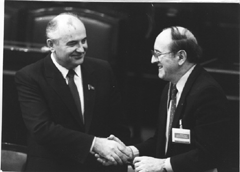
Dr. Lown with Mikhail Gorbachev (photo credit: Novosti Press Agency, Moscow)
GELLERMAN: Dr. Bernard Lown's home in Newton, Massachusetts, is filled with memories. He keeps many of them in 85 large scrapbooks--
[FLIPPING PAGES]
LOWN: Look, Allen Ginsberg was my patient. Look, Lawrence Ferlinghetti.
GELLERMAN: Poets, politicians, painters, and celebrities. Over the span of his career as a world-renowned cardiologist, 87-year-old Dr. Lown has treated them all.
Among the 5,000 books in his home is Dr. Lown’s first: "The Lost Art of Healing: Practicing Compassion in Medicine." He is professor emeritus at the Harvard School of Public Health, and the inventor of the heart-starting defibrillator.
LOWN: I was very successful medically, I developed a host of instruments, I revolutionized part of cardiology, and I was riding high and I was concerned with the issue of sudden death-
GELLERMAN: For people, and the planet. In 1985, Dr. Lown won the Nobel prize-- not for medicine, but for peace, sharing the honor with Soviet cardiologist Evgeni Chazov. Together, they founded International Physicians for the Prevention of Nuclear War.
Dr. Lown chronicles the history of the organization in his new book "Prescription for Survival: A Doctor's Journey to End Nuclear Madness" It's a behind-the-scenes look at the Cold War drama played out on the world stage, with a who's who list of characters-- their photos featured in the foyer of Dr. Lown’s home
L OWN: This is my first meeting with Gorbachev, that's Cardinal Madeiros, that is the great scientist Victor Weiskopf, and this is...

Dr. Lown with Mikhail Gorbachev (Novosti Press Agency, Moscow)
LOWN: Life is full of contradictions. The good frequently do bad, and the bad sometimes do good.
GELLERMAN: It was Albert Einstein on August 2nd, 1939 who sent a letter to FDR, telling the president that uranium could be split to produce a bomb more powerful than anything ever created, and warning that Nazi scientists were working on one.
Two years later, a day before Pearl Harbor was attacked, the United States started what would become known as the Manhattan Project. Three years after that, on August 6, 1945, the U.S. dropped an atom bomb on Hiroshima, Japan.
[BOMB SOUND]
CBS RADIO REPORT: Tokyo admits extensive damage caused by the atomic bomb at Hiroshima. New air attacks have been thrown against Japan. Washington and other allied capitals are buzzing with speculation about the new bomb and its possibilities. [FADES]
GELLERMAN: Three days later, the U.S. dropped another atomic bomb- on Nagasaki.
[BOMB SOUND]
GELLERMAN: The two bombs killed an estimated 200,000 people- the overwhelming majority, civilians.
LOWN: A nuclear weapon is an instrument of genocide, it's not a weapon of war. Whom does it kill? It kills not only people, culture, environment. It destroys everything. Such a weapon is a Hitlerite weapon and we democratic people with a deep moral sense that we pride ourselves have such weapons stockpiled?
GELLERMAN: When you won the Nobel Prize in 1985, how many nuclear weapons were there?
LOWN: There were at the time about 16,000 megatons, roughly 50,000 nuclear weapons. A megaton is one million tons of TNT. Now one million tons of TNT would take a train 400 miles long to transport. We had enough destructive capacity to kill everybody alive 20 times over.
GELLERMAN: Today, 23 years later after you won the Nobel, how much megatonnage is there, how many nuclear weapons?
LOWN: We have roughly about 15,000, we and the Russians. But it doesn’t matter, because we have enough to destroy the world. What does it matter when you have the capacity to destroy the world twice or five times?
GELLERMAN: But my question to you is, 23 years after you’ve won the Nobel Prize, we’ve got, we still have this incredible capacity to commit mass genocide, suicide. Have you succeeded, or did you fail?
LOWN: Well, both. We succeeded in the fact that instant extinction is not on the agenda. Did we eliminate nuclear weapons? Of course not. Did we teach a lot of people understanding and creative a deterrence to their use? Yes, because we gave them an image of what would happen. We gave them an image in terms of fire, destruction, radiation. We have in essence gained time for human beings.
GELLERMAN: Tell me about the co-founder of the International Physicians for the Prevention of Nuclear War, Yevgeny Chazov.
LOWN: Chazov is the ultimate doctor. He wanted to develop cardiology in Russia to the level of what he knew to be in the United States, which he respected enormously. And he was a consummate doctor.
GELLERMAN: And a consummate politician. Among Dr. Chazov's patients were members of the Soviet Politburo. Between them, the two doctors had personal and professional relationships with some of the major players of the Cold War. Within just five years, their organization, International Physicians for the Prevention of Nuclear War, had grown to 150,000 doctors worldwide.
But they had enemies as well. The Wall Street Journal called Dr. Lown a "tool of the communists" and said he and Dr. Chazov didn't deserve the Nobel Peace Prize.
GELLERMAN: The day before you getting the Nobel Prize in Norway, December 9th, 1985, and some photojournalist, a cameraman, has heart attack. You wind up, with Chazov, saving his life.
LOWN: Look at the serendipity, the coincidence. We are reviled in the press, we’re sitting in a press conference, it’s filled with journalists, red-baiting, attacking as viciously as you can imagine, Chazov primarily. In this packed news conference a Russian journalist is raising his hand and next I look around he’s on the floor, he has collapsed. Chazov and I were next to him and I’ve dealt with sudden death all my life. I recognize that it’s a cardiac arrest, it is clear to any doctor, and the place is also full of doctors.
So we start pumping on his chest and start ventilating him. And the rescue team is slow in coming, they come late, and there they roll in- the very cardio defibrillator I developed. And to me, I’m living in some other world. This couldn’t happen by chance. And they shock him, and he doesn’t recover. And the body’s led out. As they rolled him out, one of the American doctors says, ‘lets give him another shock’ and they did, and he came back. And I, almost in tears, say, ‘Look, what you have just seen is what doctoring is all about and what our movement is all about. When somebody’s threatened with cardiac arrest, we don’t ask who they are, or what they do, what their politics are, we try to save a human life. And now we’re trying to save the life of this world.’
GELLERMAN: Well, we now have this business of nuclear weapons that is a trillion dollar business, that we’re still very much in business, and still has the potential to destroy the planet and everything on it many many times over.
LOWN: But the good news is that in the Wall Street Journal a year ago, Shultz, Kissinger, Nunn, Perry, and others who were architects, essentially, of this age, the Nuclear Age, are having second thoughts. Look, now, many conservatives are coming around to believing global warming. All of these could have been foreseen. And I as a doctor realize that cure is not answer. The answer is prevention. And prevention is anticipation, is analysis. You have to know the past, and Orwell makes a marvelous statement, he says, ‘whoever controls the past, controls the future, and whoever controls the present, controls the past.’
GELLERMAN: Dr. Bernard Lown’s book, “Prescription for Survival,” is an attempt to preserve the past. To write it, he tried to get his files from the federal government.
[FLIPPING PAGES]
LOWN: Look.
GELLERMAN: And he got them.
LOWN: Look.
GELLERMAN: Sort of.
LOWN: Page after page after page totally blacked out, nothing there.
GELLERMAN: There’s nothing there. The only word on the page is “Secret-Classified by G-3.” That’s it.
LOWN: I just got a report a few months ago from the Freedom of Information from NSA, FBI, CIA, saying we regard it as against national security to divulge to you your file.
GELLERMAN: Here you are a physician trying to prevent the use of nuclear weapons, what kind of threat could you be?
LOWN: Why are you asking me, why aren’t you asking the CIA that question? I mean you’re asking me. I’m the victim.
[FLIPPING PAGES]
GELLERMAN: You know you're not just a witness to history, you made history, you changed history.
LOWN: Well, I didn’t view myself other than a doctor who’s trying to heal a sick planet.
GELLERMAN: Dr. Bernard Lown, co-founder of International Physicians for the Prevention of Nuclear War, recipient of the Nobel Peace Prize, and author of the new book “Prescription for Survival: A Doctor's Journey to End Nuclear Madness.”
Related links:
- For more about Dr. Lown’s book, click here
- International Physicians for the Prevention of Nuclear War
[MUSIC: Herbie Hancock “Sweet Bird” from ‘River: The Joni Letters’ (Verve--2008)]
GELLERMAN: On the next Living on Earth: A rapidly spreading grass from Ethiopia threatens Arizona’s iconic cacti.
HANSEN: This grass burns very vigorously with very tall flame. And it’s easily able to destroy a house, and all the plants, including saguaros, around it.
GELLERMAN: An invasive plant puts our national parks at risk, next time on Living on Earth.
[MUSIC: Richard Margoschis “Dorset” from ‘Nightingales: A Celebration’ (British Trust For Ornithology--1998)]
GELLERMAN: We leave you this week with a bird noted for its beautiful singing- the nightingale.
[NIGHTINGALE SOUNDS]
GELLERMAN: This nightingale’s song echoes across a deep valley in Dorset England- and a tawny owl joins in.
[BIRD SOUNDS]
GELLERMAN: Richard Margoschis made this recording at Fontmell Magna in 1982. It’s from the British Trust for Ornithology: Nightingale Appeal CD.
GELLERMAN: Living on Earth is produced by the World Media Foundation. Our crew includes Ashley Ahearn, Bobby Bascomb, Eileen Bolinsky, Jackson Braider, Ingrid Lobet, Helen Palmer, Mitra Taj and Jeff Young, with help from Sarah Calkins and Marilyn Govoni.
Our interns are Luke Borders, Kim Gittleson and Jessica Ilyse Smith. Jeff Turton is our technical director. Alison Lirish Dean composed our themes. You can find us at LOE dot org. Steve Curwood is our executive producer. I’m Bruce Gellerman. Thanks for listening.
ANNOUNCER: Funding for Living on Earth comes from the National Science Foundation, supporting coverage of emerging science, and Stonyfield Farm: organic yogurt and smoothies. Stonyfield pays its farmers not to use artificial growth hormones on their cows. Details at stonyfield.com. Support also comes from you our listeners, the Ford Foundation, the Town Creek Foundation, and the Oak Foundation supporting coverage of climate change and marine issues, the Skoll foundation, supporting social entrepreneurs around the world. Uncommon hero dedicated to the common good. Learn more at skoll.org. And Pax World Mutual Funds: socially and environmentally sustainable investing. Pax World: for tomorrow. On the web at paxworld.com.
ANNOUNCER 2: PRI: Public Radio International
Living on Earth wants to hear from you!
Living on Earth
62 Calef Highway, Suite 212
Lee, NH 03861
Telephone: 617-287-4121
E-mail: comments@loe.org
Newsletter [Click here]
Donate to Living on Earth!
Living on Earth is an independent media program and relies entirely on contributions from listeners and institutions supporting public service. Please donate now to preserve an independent environmental voice.
NewsletterLiving on Earth offers a weekly delivery of the show's rundown to your mailbox. Sign up for our newsletter today!
 Sailors For The Sea: Be the change you want to sea.
Sailors For The Sea: Be the change you want to sea.
 The Grantham Foundation for the Protection of the Environment: Committed to protecting and improving the health of the global environment.
The Grantham Foundation for the Protection of the Environment: Committed to protecting and improving the health of the global environment.
 Contribute to Living on Earth and receive, as our gift to you, an archival print of one of Mark Seth Lender's extraordinary wildlife photographs. Follow the link to see Mark's current collection of photographs.
Contribute to Living on Earth and receive, as our gift to you, an archival print of one of Mark Seth Lender's extraordinary wildlife photographs. Follow the link to see Mark's current collection of photographs.
 Buy a signed copy of Mark Seth Lender's book Smeagull the Seagull & support Living on Earth
Buy a signed copy of Mark Seth Lender's book Smeagull the Seagull & support Living on Earth

